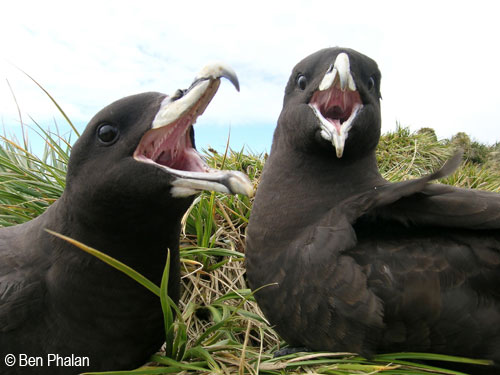Elizabeth Mackley of the United Kingdom's British Antarctic Survey and the Faculty of Biomedical and Life Sciences, University of Glasgow, along with several of her colleagues, has recently published online in the journal Marine Biology on the year-round at-sea activity patterns of White-chinned Petrels Procellaria aequinoctialis.
The paper's abstract follows:
"Despite the recent burgeoning in predator tracking studies, few report on seabird activity patterns, despite the potential to provide important insights into foraging ecology and distribution. In the first year-round study for any small petrel, we examined the activity patterns of the white-chinned petrel Procellaria aequinoctialis based on data from combination geolocator-immersion loggers deployed on adults at South Georgia. The petrels were highly nocturnal, flying for greater proportions of darkness than any large procellarid [sic] studied so far, except the light-mantled albatross Phoebetria palpebrata. Flight bout durations were short compared with other species, suggesting a dominant foraging mode of small-scale searching within large prey patches. When migrating, birds reduced the proportion of time on the water and increased flight bout duration. Activity patterns changed seasonally: birds flew least during the nonbreeding period, and most frequently during chick-rearing in order to meet higher energy demands associated with provisioning offspring. The degree of their response to moonlight was also stage dependent (greatest in nonbreeding, and weakest in incubating birds), a trait potentially shared by other nocturnal petrels which will have repercussions for feeding success and prey selection. For the white-chinned petrel, which is commonly caught in longline fisheries, these results can be used to identify periods when birds are most susceptible to bycatch, and therefore when use of mitigation and checking for compliance is critical."

Reference:
Mackley, E.K., Phillips, R.A., Silk, J.R.D., Wakefield, E.D., Afanasyev, V. & Furness, R.W. 2010. At-sea activity patterns of breeding and nonbreeding white-chinned petrels Procellaria aequinoctialis from South Georgia. Marine Biology DOI: 10.1007/s00227-010-1570-x.
John Cooper, ACAP Information Officer, 16 January 2011

 English
English  Français
Français  Español
Español